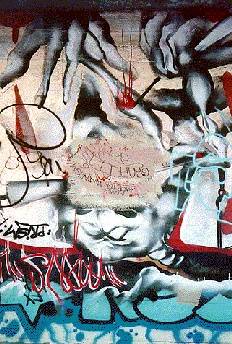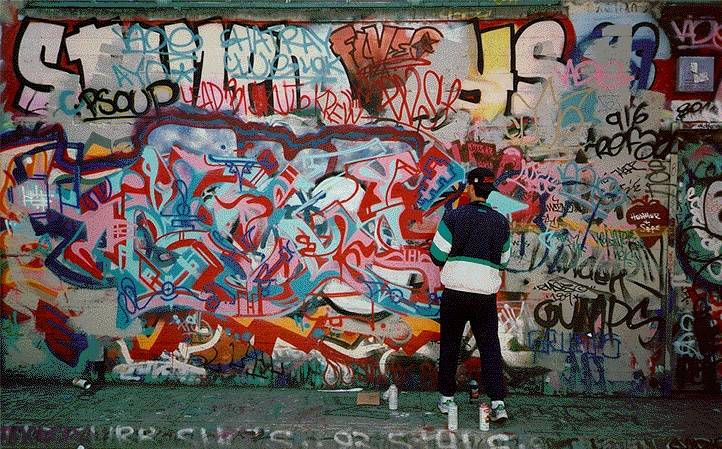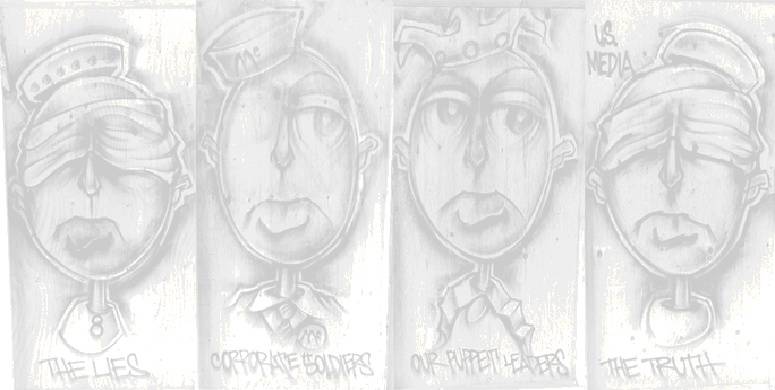Spray Can Writers Erupt: Difference between revisions
No edit summary |
No edit summary |
||
| (7 intermediate revisions by 3 users not shown) | |||
| Line 1: | Line 1: | ||
'''<font face = Papyrus> <font color = maroon> <font size = 4>Historical Essay</font></font> </font>''' | |||
''by Timothy W. Drescher'' | |||
[[Image:art1$twist-mural--detail.jpg]] | |||
'''Twist Mural -- Detail''' | |||
''Photo: D.S. Black'' | |||
[[Image:art1$twist-writing.jpg]] | |||
[[ | '''[[Twist|Twist]] at work''' | ||
''Photo: D.S. Black'' | |||
[[Image:art1$twist--the-lies.jpg]] | [[Image:art1$twist--the-lies.jpg]] | ||
Twist--The Lies | '''Twist--The Lies''' | ||
''Photo: D.S. Black'' | |||
'' | The emergence of the CAMP collective and the subsequent development of the Clarion Alley aesthetic in the ''Bloody Thursday'' ILWU Local 6 mural and the [[Redstone Murals list |Redstone Building]] mural project bespeaks the influence of the spray-can writers in San Francisco. Their aesthetic goals are inclusiveness and self-conscious repudiation of previous community muralists, even the ubiquitous models of Siqueiros and Rivera. | ||
The group's work evolves organically over long periods of time, in part because it is free from the time constraint of funding cycles. Its process is open, less hierarchically or bureaucratically controlled. Perhaps most importantly, this diversity is organic, an authentic model of the ambiguities of history, not an attempt to agree on a single message. | |||
Twist - | Nonetheless, artists in the new group share common ideas about their work and influences. The stylistic influence of comic books is observable in several younger artists. Because comic style often subverts the distinction between high and low art, it is fitting to contemporary aesthetic interests. Local artists [[Twist | Barry McGee]] and [[Rigo 90-something | Rigo]], for example, incorporate a sophisticated application of comic book principles to the artist's own ends. The conceptual level of their work is high---certainly worthy of exhibition in any galleries that offer contemporary works for sale. | ||
But McGee and Rigo, together with the rest of the city's spray can artists, have a different conception of what criteria contribute to the appropriateness of site. They favor tunnels and rooftops, partly because the Department of Public Works does not buff pieces in those locations. As anti-graffiti programs have expanded, writers have found it discouraging to have their efforts scrubbed or painted out almost immediately. McGee favors rusting surfaces, and old, abandoned areas that are marginalized anyway, so less likely to be a focus of maintenance. Not only will writings in these locations endure, the deteriorated surfaces and locations contribute to the impact of his world weary figures. | |||
City Lights Books | ''--Excerpted from the essay "Street Subversion: The Political Geography of Graffiti and Murals" by Timothy W. Drescher in ''Reclaiming San Francisco: History, Politics, Culture'' City Lights Books 1998'' | ||
[[The Twins | Prev. Document]] [[Graffiti as Ritual Transgression | Next Document]] | |||
[[ | [[category:Public Art]] [[category:1980s]] [[category:Mission]] [[category:Reclaiming San Francisco]] | ||
Latest revision as of 20:44, 21 November 2021
Historical Essay
by Timothy W. Drescher
Twist Mural -- Detail
Photo: D.S. Black
Twist at work
Photo: D.S. Black
Twist--The Lies
Photo: D.S. Black
The emergence of the CAMP collective and the subsequent development of the Clarion Alley aesthetic in the Bloody Thursday ILWU Local 6 mural and the Redstone Building mural project bespeaks the influence of the spray-can writers in San Francisco. Their aesthetic goals are inclusiveness and self-conscious repudiation of previous community muralists, even the ubiquitous models of Siqueiros and Rivera.
The group's work evolves organically over long periods of time, in part because it is free from the time constraint of funding cycles. Its process is open, less hierarchically or bureaucratically controlled. Perhaps most importantly, this diversity is organic, an authentic model of the ambiguities of history, not an attempt to agree on a single message.
Nonetheless, artists in the new group share common ideas about their work and influences. The stylistic influence of comic books is observable in several younger artists. Because comic style often subverts the distinction between high and low art, it is fitting to contemporary aesthetic interests. Local artists Barry McGee and Rigo, for example, incorporate a sophisticated application of comic book principles to the artist's own ends. The conceptual level of their work is high---certainly worthy of exhibition in any galleries that offer contemporary works for sale.
But McGee and Rigo, together with the rest of the city's spray can artists, have a different conception of what criteria contribute to the appropriateness of site. They favor tunnels and rooftops, partly because the Department of Public Works does not buff pieces in those locations. As anti-graffiti programs have expanded, writers have found it discouraging to have their efforts scrubbed or painted out almost immediately. McGee favors rusting surfaces, and old, abandoned areas that are marginalized anyway, so less likely to be a focus of maintenance. Not only will writings in these locations endure, the deteriorated surfaces and locations contribute to the impact of his world weary figures.
--Excerpted from the essay "Street Subversion: The Political Geography of Graffiti and Murals" by Timothy W. Drescher in Reclaiming San Francisco: History, Politics, Culture City Lights Books 1998



